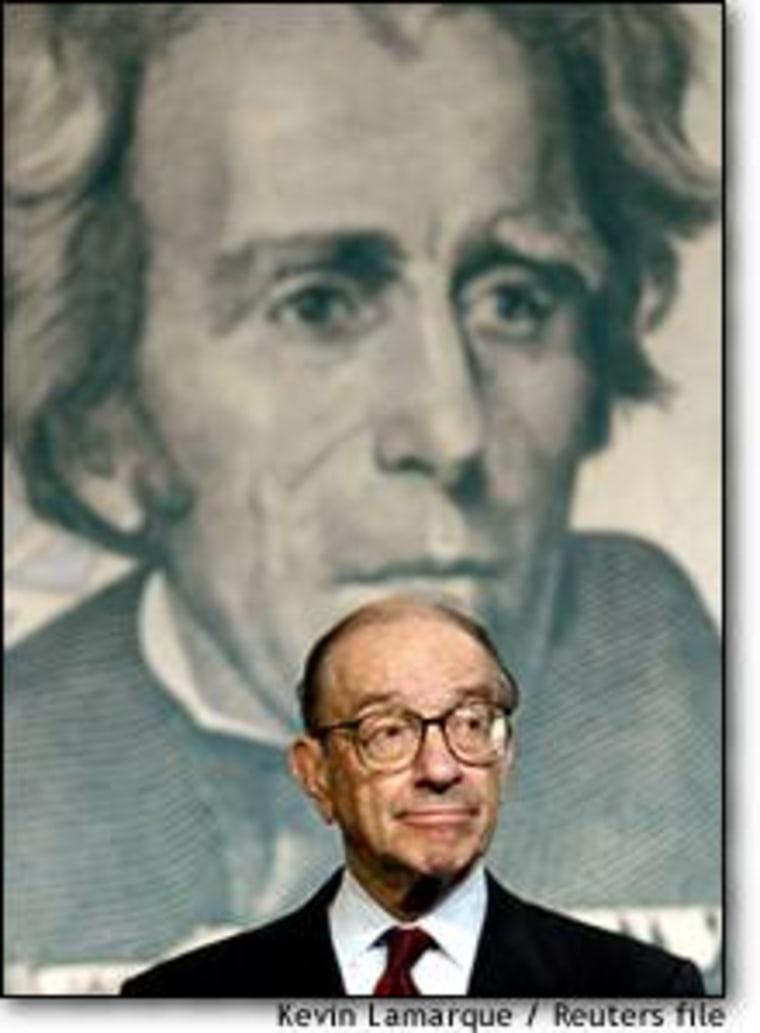When Federal Reserve Chairman Alan Greenspan appears at the Capitol Wednesday, he is sure to face a question or two about deflation and the dollar, two economic issues that have been roiling financial markets in recent weeks. Greenspan may try to quell the storm over the possibility of deflation, but if the past is any indicator he will steer a wide course around anything resembling a comment about the U.S. currency.
Greenspan's morning appearance before Congress’ Joint Economic Committee (beginning at 9:30 ET) will be watched with interest by financial markets, even though some of his testimony may repeat comments he made to a House panel just three weeks earlier. Greenspan’s appearance is the highlight of an extremely light calendar of economic events this week, and his testimony will be the first chance he has had to explain why he and other policy-makers felt compelled to warn this month of a possible “unwelcome substantial fall in inflation.”
Here are some of the main issues Greenspan can be expected to address:
Deflation and disinflation — To say that the Fed made waves with its comment about disinflation May 6 would be an understatement. The bond market took off in a dramatic rally, sending long-term interest rates, including mortgage rates, down to their lowest levels in more than 30 years.
Chairman Greenspan undoubtedly will be questioned about the prospects for deflation, a sustained broad downturn in prices which could be disastrous for the economy, sending it into a Japan-like downward spiral. Greenspan is likely to stress he believes deflation is extremely unlikely, say some analysts, who believe markets overreacted to the Fed’s statement.
Perhaps more interesting will be any comments Greenspan makes on falling inflation. The inflation rate apparently has fallen below the Fed’s preferred target, and Greenspan may be asked to explain why it is a problem for the economy if the inflation rate falls too low. He is unlikely to provide any guidance on the Fed’s preferred range for inflation or even whether it has an explicit target.
But he might comment on how the Fed plans to fight low inflation as its short-term interest rate nears zero. A study by the Joint Economic Committee this week concluded that the Fed has several tools beyond its control of market interest rates.
The dollar — Currency markets have been rocked in recent weeks by comments from Treasury Secretary John Snow seen as implying that the Bush administration does not mind seeing the dollar weaken. White House officials have hastened to declare that there has been no change in U.S. policy supporting a “strong dollar.”
But a declining dollar, which is at least partly a result of the Fed’s long campaign to cut interest rates, tends to boost the economy and particularly corporate profits by making U.S.-produced goods and services cheaper overseas.
Fed Gov. Ben Bernanke has gone so far as to suggest that the central bank could use its influence to devalue the dollar if needed to fight deflation. But for Greenspan to make any comment at all on the dollar would be a complete shocker. In the past Greenspan has used boilerplate language to decline any comment on the greenback, citing the traditional role of the Treasury as the lead agency for setting U.S. policy on the dollar.
Economic growth — Greenspan has consistently expressed optimism that the economy will rebound now that the Iraq war is over. So far there has been little if any evidence of a bounce, but Greenspan is likely to emphasize favorable financial conditions including a rising stock market, falling energy prices, improved consumer confidence and relatively lower rates for corporate credit.
Greenspan also might choose to emphasize that most of the recent disappointing economic news has reflected conditions that prevailed in early April before the conclusion of the war’s heaviest fighting. Regional surveys published by two branches of the Fed last week detected a slight improvement in the manufacturing sector, and new claims for unemployment insurance have fallen for three straight weeks.
Interest rates — Many economists believe the Fed is likely to cut short-term interest rates by a at least a quarter-percentage point at the next scheduled meeting of policy-makers June 24-25, and perhaps even sooner. Fed watchers will be listening carefully for any hints on whether Greenspan believes another rate cut will be needed.
In the past, despite Greenspan’s justly famous talent for obfuscation, the Fed chief has managed to give cues that signal whether a rate cut is likely. If Greenspan were in a mood to be particularly blunt, he also could say that any Fed decision is likely to be heavily dependent on economic data reported between now and then, especially the May employment report due June 6. A fourth straight month of job losses would all but assure another rate cut, several market analysts said.
Divisions at the Fed — Last week the Fed released minutes revealing that two regional central bank presidents had asked policy-makers to lower a key interest rate known as the the discount rate. The request was denied, but the news was the latest evidence of a split among central bankers — between economic optimists, led by Greenspan, and others who believe the Fed needs to act more aggressively to prevent the economy from deteriorating further.
Greenspan is unlikely to refer directly to any dissent on the Fed’s policy-making board, but Fed watchers point out that the chairman can be expected to express his own viewpoint even more freely than he did when he last testified April 30. That is because the previous testimony was considered a continuation of his congressionally mandated semiannual report on the economy, when he seeks to represent the consensus view of Fed policy-makers. Wednesday testimony is one of the occasional visits to Capitol Hill Greenspan makes outside the formal structure of the twice-yearly reports he makes to each chamber.
